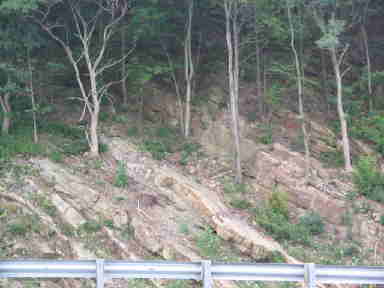![]() Observation: The First Step in the Scientific Method
Observation: The First Step in the Scientific Method
To observe means to look at something carefully and to notice the details. When people observe things they often wonder why it is that way. Scientists strive to answer that question. They make observations as the first step to the scientific method.
Observations are also called data. There are two kinds of data.
- Qualitative data are descriptions that do not have numbers.
It is so gloomy outside today the street lights are on - is an example of qualitative data.
- Quantitative data are obtained by measuring and have numbers. Scientists use instruments (tools) to obtain numbers based data.
The student's light meter read 100 lux, on the playground, at 1200 GMT is quantitative data.
It is important to be a careful observer. The smallest detail could be important to finding the answer to a question.
Practice observing by looking at this photo.
I observed this on top of Bald Eagle Mountain, South Williamsport, Lycoming County, Pennsylvania on Oct. 26, 2008.
Click here for a closer view. Use the Back Button of your browser to return to this web page.
![]() 1. Write your observations.
1. Write your observations.
2. Imagine - If you were standing in the scene:
What tools (instruments) would help you to be a better observer?
What tools (instruments) would you use to measure what you are observing?
3. Write at least one hypothesis about what you have observed.
4. TAI (Think About It) Do you expect that this will be the same a year from now?
A decade later?
A score from now?
In a century?
What data do you expect to see change over time?
Journey further:
Interactive Rock Cycle Animation | Weathering | Geography4Kids - Weathering
About Units of Measurement - IB Biology | Observing Biology how to's
The Math and Science Partnership Network
Observation Skills Builders | The Scientific Process
Steps of the Scientific Method - Science Buddies | Learn about the Scientific Method Activity
"Research is what I'm doing when I don't know what I'm doing." Wernher Von Braun
Geology of Pennsylvania | Earth Layers Internet Activity | Bluebirds Project | Rocks for Kids | Rockhounds
![]()
All trademarks, copyright and logos belong to their respective owners.
Internet Hunts / Nature / Water & Watershed Studies / Computers / Famous Pennsylvanians / Civics & History / Puzzles & Projects / Site map / Home
Posted
by Cynthia J. O'Hora 3/2009, released for noncommercial use by nonprofit organizations
Aligned
with Pennsylvania Academic Standards | Assessment and Rubrics
![]() Save a tree use a digital answer format - Highlight the text. Copy it. Paste it in a word processing document. Save the document in your folder. Answer on the word processing document. Save frequently as you work. I have never liked losing my work. You will not like it either. Be sure to enter your name & the date at the top of the document. Submit via email attachment or class dropbox. Bad things happen: Save a copy of the response document for your records.
Save a tree use a digital answer format - Highlight the text. Copy it. Paste it in a word processing document. Save the document in your folder. Answer on the word processing document. Save frequently as you work. I have never liked losing my work. You will not like it either. Be sure to enter your name & the date at the top of the document. Submit via email attachment or class dropbox. Bad things happen: Save a copy of the response document for your records.
Proof read your responses. It is funny how speling errors and typeos sneek in to the betsworck. ![]() Make your own printer paper answer sheet
Make your own printer paper answer sheet
National Science Education Standards:
CONTENT STANDARD G: As a result of activities in grades 9-12, all students should develop understanding of:
NATURE OF SCIENTIFIC KNOWLEDGE
Scientific explanations must meet certain criteria. First and foremost, they must be consistent with experimental and observational evidence about nature, and must make accurate predictions, when appropriate, about systems being studied. They should also be logical, respect the rules of evidence, be open to criticism, report methods and procedures, and make knowledge public. Explanations on how the natural world changes based on myths, personal beliefs, religious values, mystical inspiration, superstition, or authority may be personally useful and socially relevant, but they are not scientific.
Because all scientific ideas depend on experimental and observational confirmation, all scientific knowledge is, in principle, subject to change as new evidence becomes available. The core ideas of science such as the conservation of energy or the laws of motion have been subjected to a wide variety of confirmations and are therefore unlikely to change in the areas in which they have been tested. In areas where data or understanding are incomplete, such as the details of human evolution or questions surrounding global warming, new data may well lead to changes in current ideas or resolve current conflicts. In situations where information is still fragmentary, it is normal for scientific ideas to be incomplete, but this is also where the opportunity for making advances may be greatest.
